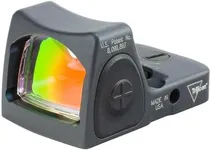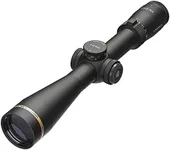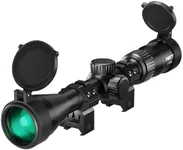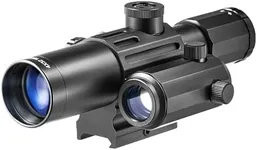Buying Guide for the Best Sniper Scopes
Choosing the right sniper scope can significantly enhance your shooting accuracy and overall experience. It's important to understand the key specifications and how they align with your specific needs. Whether you're a beginner or an experienced shooter, knowing what to look for in a sniper scope will help you make an informed decision. Here are the key specs to consider when selecting a sniper scope and how to navigate them.MagnificationMagnification refers to how much closer the target appears through the scope compared to the naked eye. This is crucial because it determines how well you can see your target at various distances. Scopes with lower magnification (1-4x) are suitable for short-range shooting, offering a wider field of view and easier target acquisition. Medium magnification (5-12x) is ideal for mid-range shooting, providing a balance between field of view and target detail. High magnification (12x and above) is best for long-range shooting, allowing you to see distant targets clearly but with a narrower field of view. Choose the magnification based on the typical distances you plan to shoot.
Objective Lens DiameterThe objective lens diameter is the size of the front lens of the scope, measured in millimeters. This spec is important because it affects the amount of light that enters the scope, impacting image brightness and clarity. Larger diameters (40-56mm) allow more light, making them better for low-light conditions like dawn or dusk. However, they can also make the scope heavier and bulkier. Smaller diameters (20-40mm) are lighter and more compact but may not perform as well in low light. Consider where and when you'll be shooting to determine the right objective lens size for you.
ReticleThe reticle, or crosshair, is the aiming point you see when looking through the scope. Different reticle designs serve various purposes. Simple crosshairs are good for general shooting, while more complex designs like mil-dot or BDC (Bullet Drop Compensator) reticles help with range estimation and bullet drop compensation. Illuminated reticles are useful in low-light conditions. Choose a reticle based on your shooting style and the level of precision you need.
Parallax AdjustmentParallax adjustment helps ensure that the reticle stays on target even if you move your eye slightly. This is important for long-range shooting where precision is critical. Scopes with adjustable parallax allow you to fine-tune the focus at different distances, reducing aiming errors. Fixed parallax scopes are simpler and sufficient for short to mid-range shooting. If you plan to shoot at varying distances, especially long-range, a scope with parallax adjustment is beneficial.
Field of ViewField of view (FOV) is the width of the area you can see through the scope at a given distance, usually measured in feet at 100 yards. A wider FOV allows you to see more of the surroundings, making it easier to track moving targets and acquire new ones. Lower magnification scopes typically offer a wider FOV, while higher magnification scopes have a narrower FOV. Consider your need for situational awareness versus target detail when choosing the FOV.
Eye ReliefEye relief is the distance between your eye and the scope where you can see the full image. This is important for comfort and safety, especially with high-recoil rifles. Longer eye relief (3-4 inches) is better for high-recoil firearms, preventing the scope from hitting your eye. Shorter eye relief (1-3 inches) can be acceptable for low-recoil rifles. Choose eye relief based on the type of rifle you use and your comfort level.
TurretsTurrets are the knobs on the scope used to adjust windage (left/right) and elevation (up/down). Precise and easy-to-use turrets are crucial for making accurate adjustments, especially at long ranges. Some scopes have exposed turrets for quick adjustments, while others have capped turrets to prevent accidental changes. Consider how often you'll need to make adjustments and whether you prefer quick access or protection from accidental movements.





















